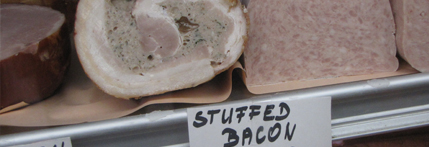at Columbia College’s Averill and Bernard Leviton A + D Gallery

By Mia Dimeo, Staff Writer
With fashion trends in constant flux and retailers producing clothes cheaper than ever before, sustainable fashion is not a concept ingrained in 21st century American culture. Demand for new clothes increases wasteful production, with approximately 15 percent of fabric discarded during the creation of the average garment. “No Waste/Zero Waste” at Columbia College’s Averill and Bernard Leviton A + D Gallery shows art and clothing that makes creative use of that excess, and strives to educate the viewer on the processes and design techniques that counteract fashion’s detrimental impact on the environment.

Curated by Arti Sandhu, Assistant Professor of Fashion Design at Columbia College, the exhibit places avant-garde styles alongside street-ready looks, along with projects that repurpose unwanted clothing as a sculptural medium. Derick Melander’s impressive “Drift” fills the street-facing windows of the gallery with a 2.5 ton stack of thrift store castoffs. A video shows a team of people installing the piece with wood supports, creating an effective visual demonstration of the exhibiton’s ideals.

Three dresses from the “Regurgitate” series by Nick Cave, SAIC’s Fashion Department Chair, are neutral compositions made from recycled men’s dress shirts, porch screens, plastic tags, and other materials.
Pre-existing folds and buttons are emphasized rather than disguised, and used architecturally, resulting in feminine high-style looks with a conscience.
In a similar vein, Maison Martin Margiela’s Artisanal Line makes designs that celebrate the reused material. Handmade by fine ateliers in Paris, a puffy vest made from insulated ski gloves and a geometric sweater woven together from gray-toed socks are eloquent illustrations of Margiela’s whimsical aesthetic, and the possibilities of sustainable fashion. His sexy, strappy vest woven together from leather sandals is a highlight in the exhibit, demonstrating the deconstructionist fantasy for which the Artisinal Line has been famous since the late 1980s.
The rest of the exhibit looks at sustainable fashion that features the construction process and DIY ethos front and center. Framed pages from the Belgian publication A Magazine show how to make your own Margiela sock sweater. Red gingham sheets that Timo Rissanen inherited from his grandmother’s dowry, repaired and sewn into a set of men’s pajamas are also on display, showing the transformation of sentimental, vintage fabrics into a new object, but one that still retains its sleep-oriented function.

Padmaja Krishnan’s intricate process of puzzling scraps together into “Boor” pieces borrows from traditional Indian quilting techniques and color palettes. Designs like the “Kali” jacket introduce the idea of no-waste patternmaking. Holly McQuillan’s zero-waste patterns are framed as colorful wall art, and the monochrome black ensembles that the patterns produced are the sleekest, most wearable designs in the exhibit, proving fashion that uses every bit of fabric can be practical and stylish. Sandu has been the head of a zero-waste project at Columbia for two years, and student reactions to the exhibit are currently featured in the windows of Columbia’s nearby 33 East Congress building.
In all the text and statistics about the environmental damage that mindful fashion production and re-use can prevent, there’s no mention in this exhibition of sweatshops and other human rights issues related to garment manufacturing in factories around the world. This was probably sidestepped to keep the focus on the optimism and creativity at work in sustainable fashion practices today. As a whole, “No Waste/Zero Waste” promotes awareness about the temporal nature of fashion, and helps to produce sustainable design opportunities that can bring some balance to the system.
Zero Waste: Fashion Re-patterned
March 3 – April 16, 2011
A + D Gallery
619 S Wabash
www.colum.edu







